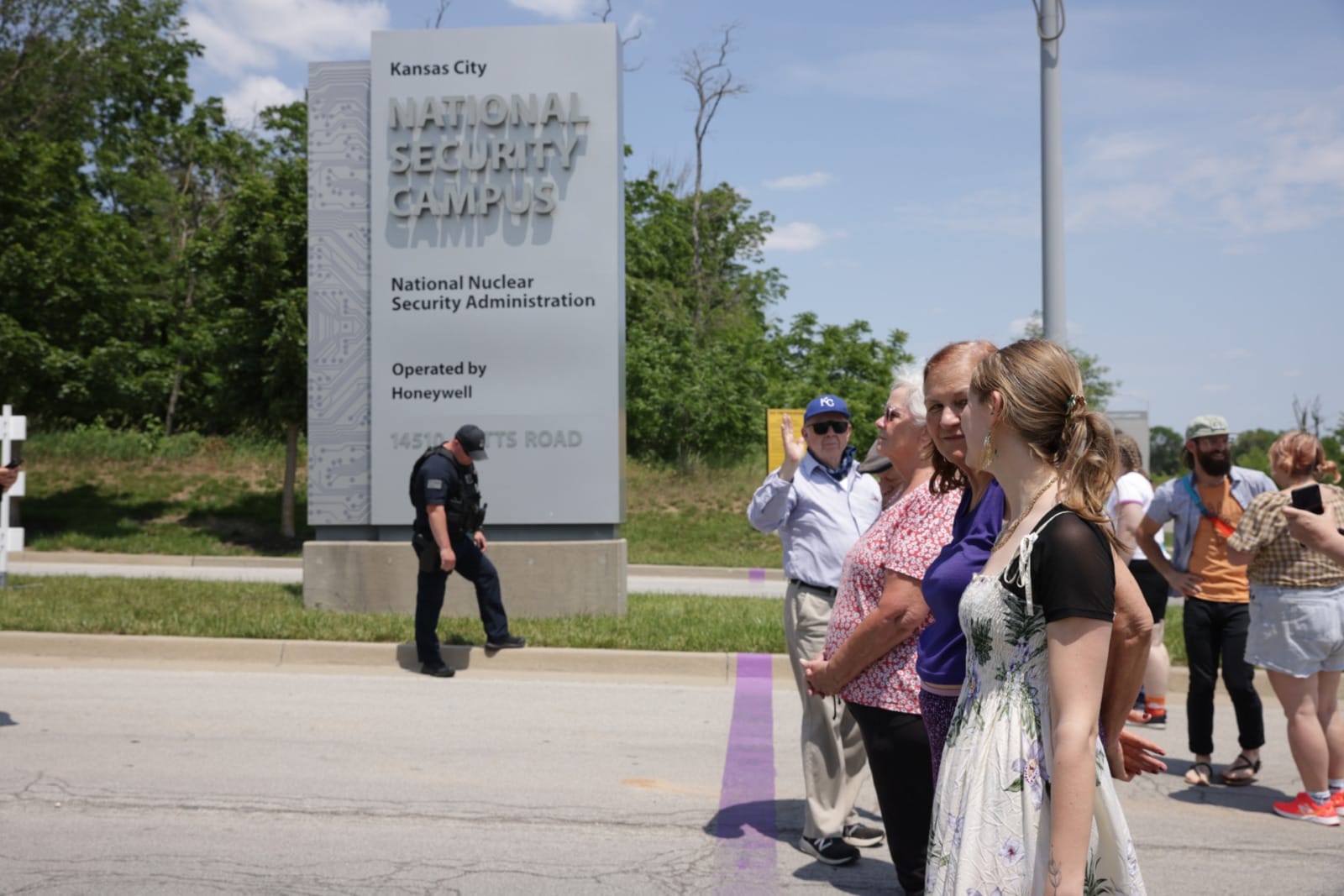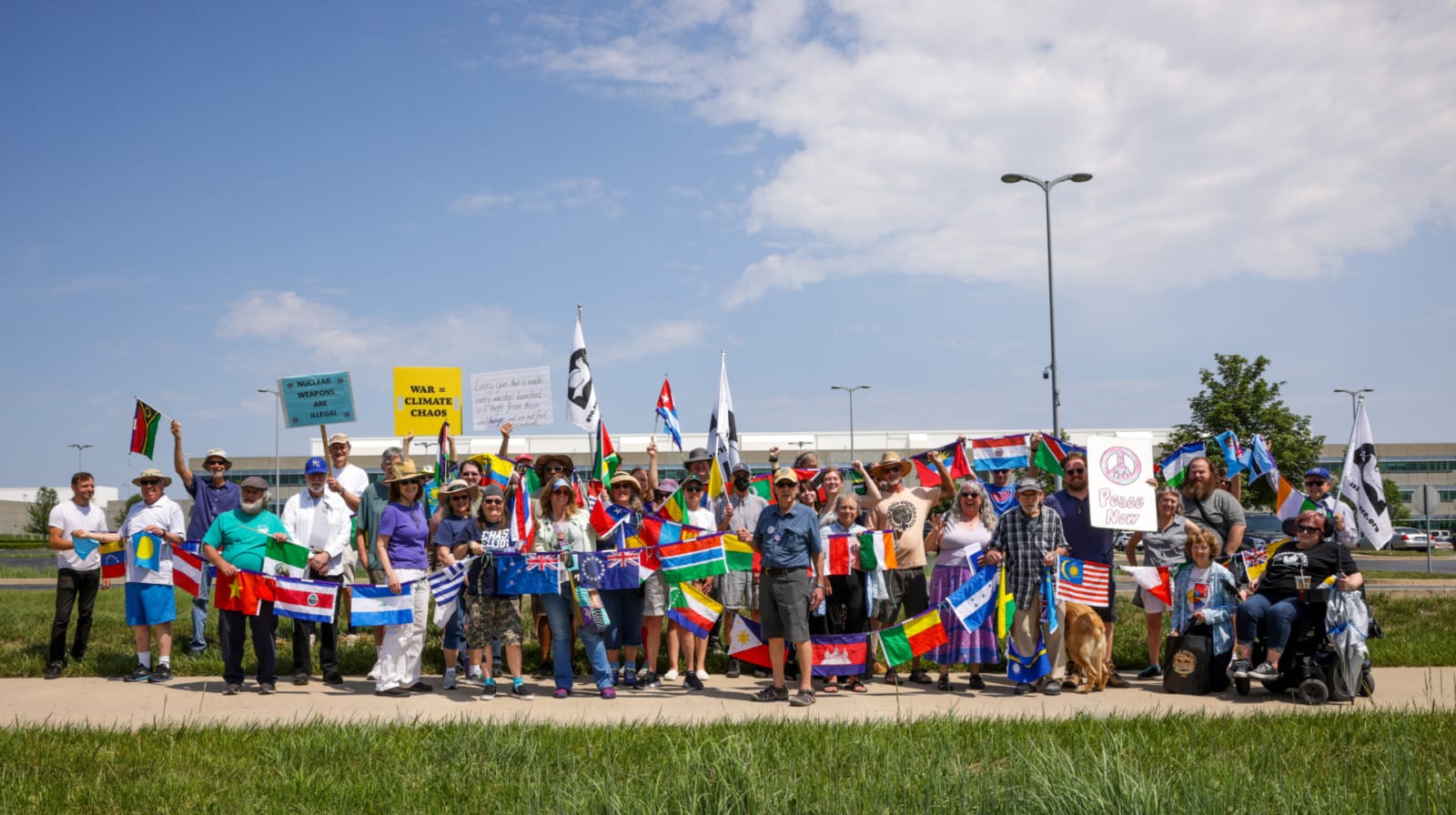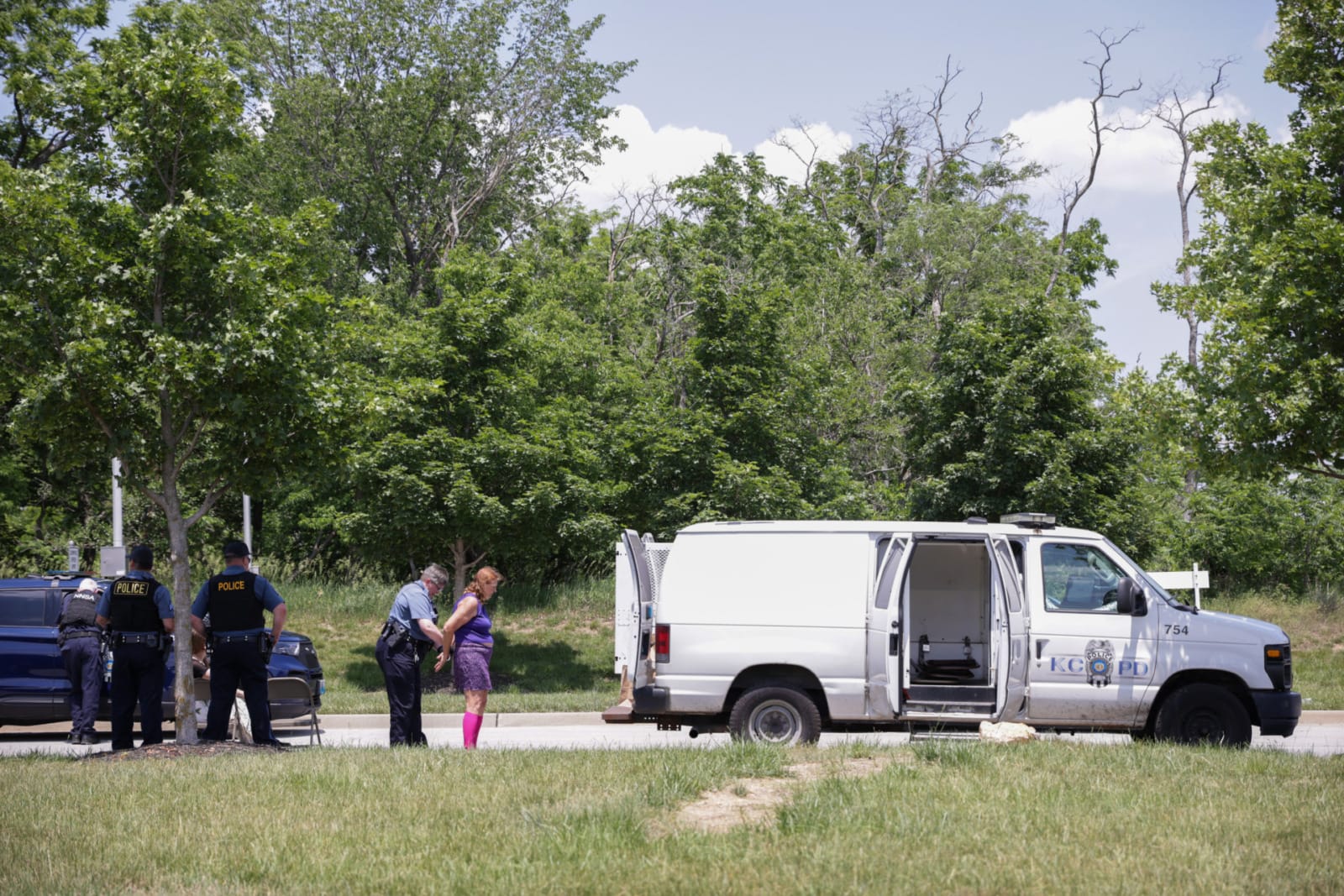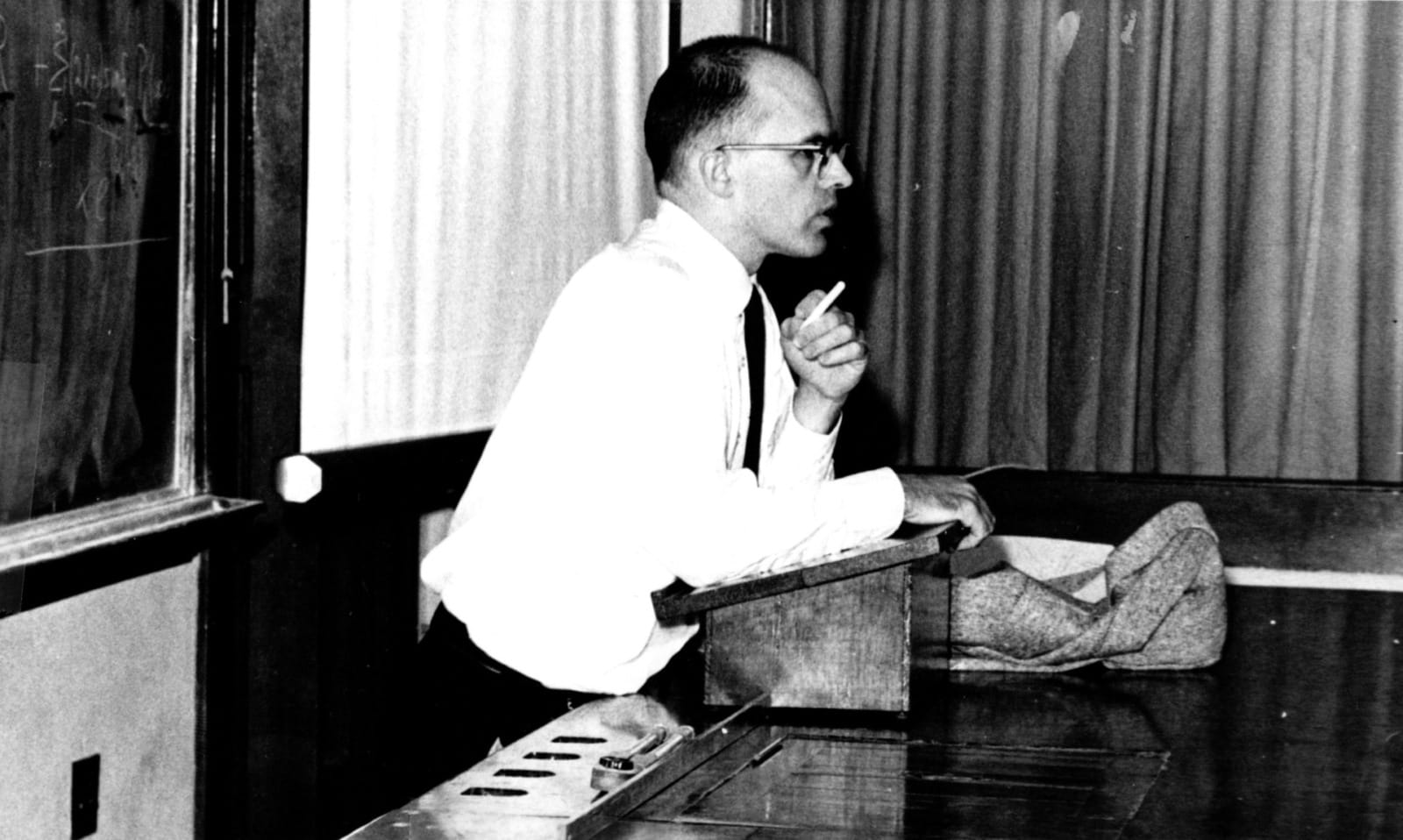Anti-Nuclear Activist Goes on Trial Amid the Fallout of Oppenheimer’s Legacy Kansas City’s Ties to the Bomb
Published November 10th, 2023 at 11:56 AM
Above image credit: Ann Suellentrop and members of PeaceWorks KC gather outside of the Jackson County Courthouse. (Clarence Dennis | Flatland)“At time zero the first thing I noticed was that although facing away from ground zero, it felt like someone had slapped my face: it was of course the heat radiation from a most successful test.”
– Hugh Richards, Ph.D., “Through Los Alamos, 1945: Memoirs of a Nuclear Physicist”
Last month, Ann Suellentrop, 71, stood before a judge in the 16th Judicial Court of Missouri.
A retired maternal-child nurse and lifelong activist, Suellentrop was one of three people arrested for trespassing during a Memorial Day protest organized by PeaceWorks KC at the National Security Campus of the National Nuclear Security Administration (NNSA) in south Kansas City earlier this year.
The only property line crosser who would plead not guilty, Suellentrop represented herself in court on Oct. 25. She argued that intentionally crossing the alleged boundary line by 10 feet or less, approximately three-fourths of a mile from the NNSA facility, was not trespass, but a peaceful, “limited protest” on a matter of principle and should not result in fines or jail time.
Facing a $500 fine, six months in jail, or both, the defendant argued her action was an expression of her First Amendment rights and stressed that advanced notice and planning of the annual protest was communicated to police and NNSA campus officials.

In front of more than a dozen supporters sporting bold black stickers that read “NO NUKES Y’ALL,” Suellentrop raised points to Judge Anne LaBella about her own character, the nature of her peaceful protest and the threats nuclear weapons and nuclear terrorism pose to human health and society.
Facing a slew of objections based on relevance and witness testimony from the NNSA campus security guard who was on duty during the protest and warned the protesters to step off the property, all signs pointed to a guilty verdict.
Moments after all arguments were heard and the city rested its case, the prosecutor asked the judge to amend the charge to include NNSA campus administrator Honeywell Federal Manufacturing and Technologies.
Judge LaBella said the request came too late and she would not amend the charge. She then promptly announced her ruling on Suellentrop’s case.
Not guilty.
Modern-Day Peaceniks
A member of PeaceWorks KC and the Alliance for Nuclear Accountability, Suellentrop has been arrested twice before in protests at the NNSA campus. The facility manufactures 80% of the non-nuclear components that go into the national nuclear stockpile.
This week, the Kansas City Business Journal reported plans advancing through city planners that would more than double the size of the facility, an expansion that could result in an estimated 1,000 new jobs.
“Our ultimate goal is to convert the plant into a peaceful production of hopefully something that can fight the environmental crisis that’s going on. We need those brains, those skills and that money to convert it into something we really need,” Suellentrop said ahead of the trial.

Immediately following the verdict, Suellentrop and her peacenik partners picked up where her testimony left off. The group of mostly older adults gathered outside of the Jackson County Courthouse, taking turns passing a child’s toy microphone, celebrating the win and speaking about the threat nuclear weapons present to anyone who would listen.
“Because there is a group of old people, it doesn’t mean we are wrong. Historically, civil disobedience has played a big role in changing things,” said PeaceWorks KC board chair Chris Mann.
Mann, 73, participated in her first protest in college – a silent vigil during the war in Vietnam.
“Our group is becoming increasingly younger… a tradition of civil disobedience is only one of the measures,” Mann said, speaking to the makeup of PeaceWorks KC. “We think that younger people have a hard way to go now.”
A fellow product of the 1960s, Suellentrop says she has always had the predisposition to stand up for what she believes is right.
In 1968, 16-year-old Suellentrop dated a young man in the Air Force. She remembers the service member taking her to his work facility near Wichita.
“It’s just a little white building. I go in there. We go down the elevator. And he takes me out and he says, ‘Hey, look at this.’ And he opens this door and I saw I see an ICBM (intercontinental ballistic missile) underground. I couldn’t believe it.”
The experience, plus an admiration for Australian physician, author and anti-nuclear advocate Helen Caldicot, fueled a lifetime of activism for Suellentrop, particularly in anti-nuclear efforts.
As for what keeps her civil disobedience going into her 70s, Suellentrop points to her faith.
“Like any person, I have fears and worries and self-doubts and what have you, but I just go to God and prayer,” Suellentrop said. “I get an overwhelming feeling of, ‘I got this.’ God is good and he’s opposing this – and this is an unspeakable evil.”

Kansas City’s Nuclear Legacy
This summer, director Christopher Nolan’s “Oppenheimer” became the highest-grossing World War II film of all time.
The film centered on theoretical physicist J. Robert Oppenheimer and the personal and professional dilemmas that came with spearheading the development of the world’s first nuclear bomb, a project that has significant ties to the Kansas City region.
As it turns out, three Park University (formerly Park College) graduates and pupils of physics professor Dr. Roger Roberts played a role in the Manhattan project and at Los Alamos.
Leavenworth, Kansas, native John Cory left Parkville in 1942 and eventually studied works of Danish physicist Niels Bohr and moved to New York City, joining the group of scientists doing early work on the project code-named after the borough.
Missouri small-town native Joseph McKibben, a 1939 graduate, and 1933 grad Hugh Richards, played a major part in Oppenheimer’s project, detonating and measuring the destruction of the world’s first atomic bomb.
In 1942, nine academic institutions were working on the Manhattan Project in some capacity. Richards was on the project at Rice University in Texas. His fellow Park alum McKibben was doing similar work on campus at the University of Minnesota.
The research projects were shrouded in secrecy – even from many of those who were doing the calculations in laboratories across the country.
“Both McKibben and Richards wrote that they were realizing that A, if (the project) works and B, if it’s implemented, their work would open a ‘pandora’s box’ and there would be huge ramifications for all of mankind if these devices are actually used,” said Park University history professor and archivist Dr. Tim Westcott.

While there is no record of McKibben and Richards writing one another and connecting over their shared Parkville roots, Westcott said it is fair to assume the two “bumped into each other” at the top-secret site in the middle of the New Mexico desert.
The Trinity Test
On the morning of July 16, 1945, McKibben and Richards started their workday early, 210 miles south of Los Alamos.
It was time to test the world’s first nuclear bomb.
Both Park College grads played an integral part in turning years of calculations in theoretical physics into 18.6 kilotons of power capable of real mass destruction.
Richards was called to lead a team in recording the pending blast’s neutron measurements and neuron intensity.
He wrote about the tense moments before the bomb dropped in his book, “Through Los Alamos, 1945: Memoirs of a Nuclear Physicist.”
“We had been issued dark welding goggles to shield our eyes and had been instructed to lie down away from ground zero. We followed the countdown over a loudspeaker: 10, 9, 8, 7, 6, 5, 4, 3, 2, 1.”
Also closely following the countdown was McKibben, who, at “zero,” became forever known as, “the man who pushed the button.”
“As the time approached to test the bomb in southern New Mexico, it was determined considerably more support to the staff for the timing system was needed. I was selected for that job,” McKibben later wrote to his classmates on the 50th anniversary of his graduation from Park College.
“The neighboring mountains were vividly illuminated, and I turned around, took off my welder’s goggles and watched the luminous fireball change color expand and rise majestically upward,” Richards wrote.
On Aug. 6 and Aug. 9, 1945, less than a month after McKibben flipped the final switch on the world’s first nuclear weapon test, President Harry Truman dropped a nuclear bomb on Hiroshima and Nagasaki, Japan, respectively.
The bombs killed an estimated 129,000 to 226,000 people – mostly civilians.
Taking Responsibility
Asked if folks living in Kansas City should bear a certain level of responsibility or accountability regarding living in the nuclear age, given the region’s ties to the development of the bomb and continued manufacturing of parts, Suellentrop, who held a Q&A following the release of “Oppenheimer,” gave a clear answer.
“One hundred percent, yes,” Suellentrop said. “It’s just got to be in your thoughts first, you need to have that realization, that conviction and then your words, later, become actions.”
Mann feels the responsibility falls on the shoulders of every American.
“Overall, this was our country that had the buildup of weapons, and we are the only country that has used the weapons,” she said.
“I would not put the emphasis on a certain area or group of people, but the fact that our direction is to efficiently blow the world up – that should weigh on all of us.”
Members of PeaceWorks KC plan to join Kansas City Veterans for Peace for an annual bell ringing for peace ceremony at the National World War I Museum and Memorial Saturday, November 11, at 11 a.m.
Clarence Dennis is audience and digital content strategist with Flatland.


